Firefly Variations
11 Comments
In this post, I revisit a firefly photograph in some detail, first comparing it to a similar image made with a different technique, then showing its components images to highlight firefly specifies within.
Single exposure v. Digital composite
I mentioned previously that there are two approaches to photograph fireflies together with the forest, a carefully timed single long exposure or a digital composite from several short exposures. Even if you are not going to photograph fireflies any time soon, note that those considerations also apply to star trails or even light trails from cars at night. The composite approach is safer for several reasons. The first reason is that it makes it possible to use a base exposure while there is still light, so that one can avoid high ISO and a long exposure, a combination particularly problematic, as taken individually, each of them is already the main cause of noisy images. The second reason is that besides noise, a single, long exposure is vulnerable to incidents such as someone shining a light. With several short exposures, you have the option of simply not using the affected frames, whereas a single exposure could be ruined beyond repair. The third reason is that it makes it easier to control the brightness of the final image. If you do not time well a single exposure and it is too long, the forest may end up too bright relative to the fireflies, which would ruin the shot. With separate exposures for the forest and the fireflies, you can easily tune their relative brightness.With the lens set wide open at f/1.4, I focussed at infinity. This resulted in the light from the fireflies forming an out of focus disc of size inversely proportional to their distance, which helped convey the sense of the depth in the forest I had in mind for this photograph. Unlike for others, I had chosen a slightly elevated viewpoint to this effect. However, in the single exposure frame below, some fireflies had flown very close to the camera, resulting in blobs of light that could be distracting.
Single frame, Sony A7R2, Rokinon 35mm, 8 min at f/1.4, ISO 800 (Click image to enlarge)
For the digital composite, I selected 13 frames, leaving out those with distracting fireflies, resulting in a similar total exposure time. I loaded them as layers in a stack by using “Tools > Photoshop > Load Files into Photoshop Layers” in Bridge (you can also do that directly in Photoshop with “Files > Scripts > Load Files into Stack”). Then in the Layers palette, I selected all the layers and changed the blending mode from “Normal” to “Lighten”. The “Lighten” blending mode creates a composite by taking for each location the brightest pixels in the stack, and since the fireflies are brighter than the forest, I was done. I tried to use a brigher base exposure for the forest, but eventurally prefered the darker exposure from the first frame of the stack.
Digital composite, Sony A7R2, Rokinon 35mm, 13 frames, 30 sec at f/1.4, ISO 1600 (Click image to enlarge)
I’d appreciate it if you would let me know which of the two is your favorite? Does it matter that a photo was captured as a single exposure, or does only the result count?
Create your own user feedback survey
Click here to answer poll if you don’t see window above
Photinus frontalis v. Photinus carolinus
Another benefit of making several short exposures is that the individual frames reveal the light patterns of different firefly species better than a single long exposure or a composite does, even if the later is more impressive by virtue of the myriad of lights captured. In the two photographs above, the fireflies appear to be all over the place, blanketing the forest. However, the 30-second exposures let you see the long light trails of the Mammoth Cave National park fireflies with evenly spaced blinks like the Photinus frontalis species. The animated GIF below consists of the 13 frames that make up the composite.Mammoth Cave National Park fireflies (click image to enlarge)
By contrast, the Photinus carolinus of Great Smoky Mountains National Park have shorter light trails, since they blink only 5-8 times before going dark for a period of time longer than the flashing time. This can be seen in the animated GIF below.
Great Smoky Mountains National Park Photinus carolinus fireflies (click image to enlarge)
The difference in flashing patterns was not as readily observed in the final composite image below:
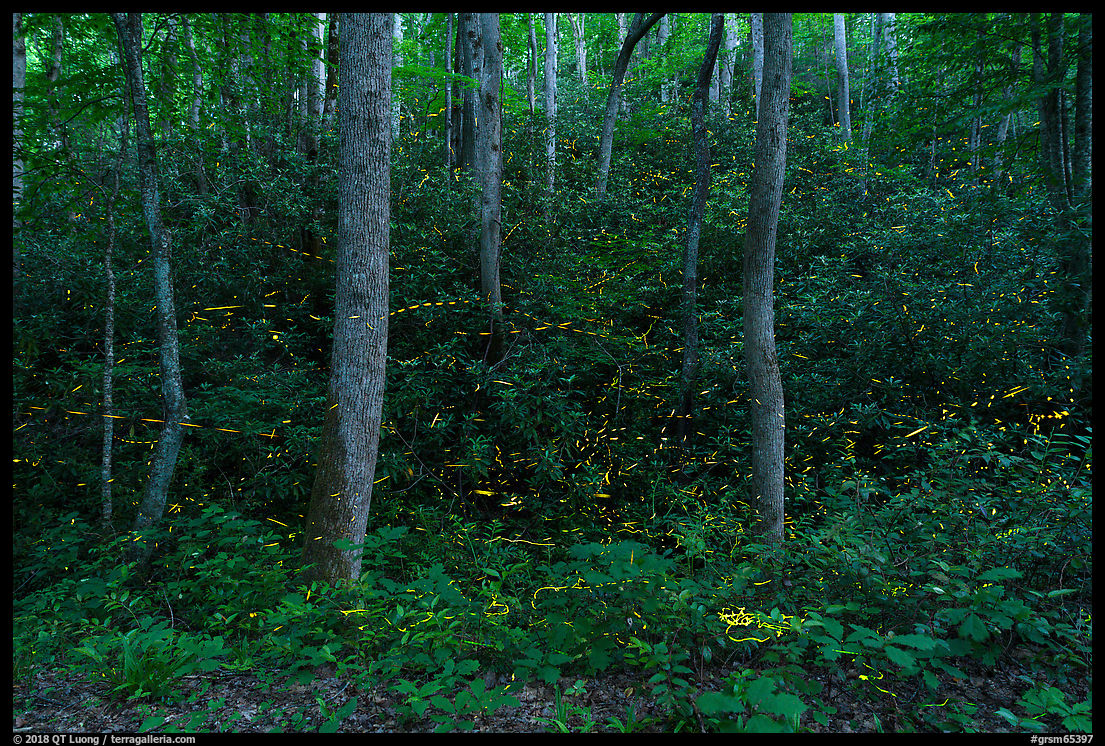
Digital composite. Sony A7R2, Sigma 20mm f1.4 lens. Base exposure: 30s at f/2.2, ISO 200. Fireflies: 28 frames, 30s at f/1.4, ISO 3200
I hope that this series of posts has inspired you to go and seek these bioluminescent beauties that bring enchantment to summer evenings in the eastern forests, and has given you enough information to try your hand at photographing them. Firefly populations are on the decline, due to increased light pollution and habitat loss, so while enjoying them, be sure to thread lightly!
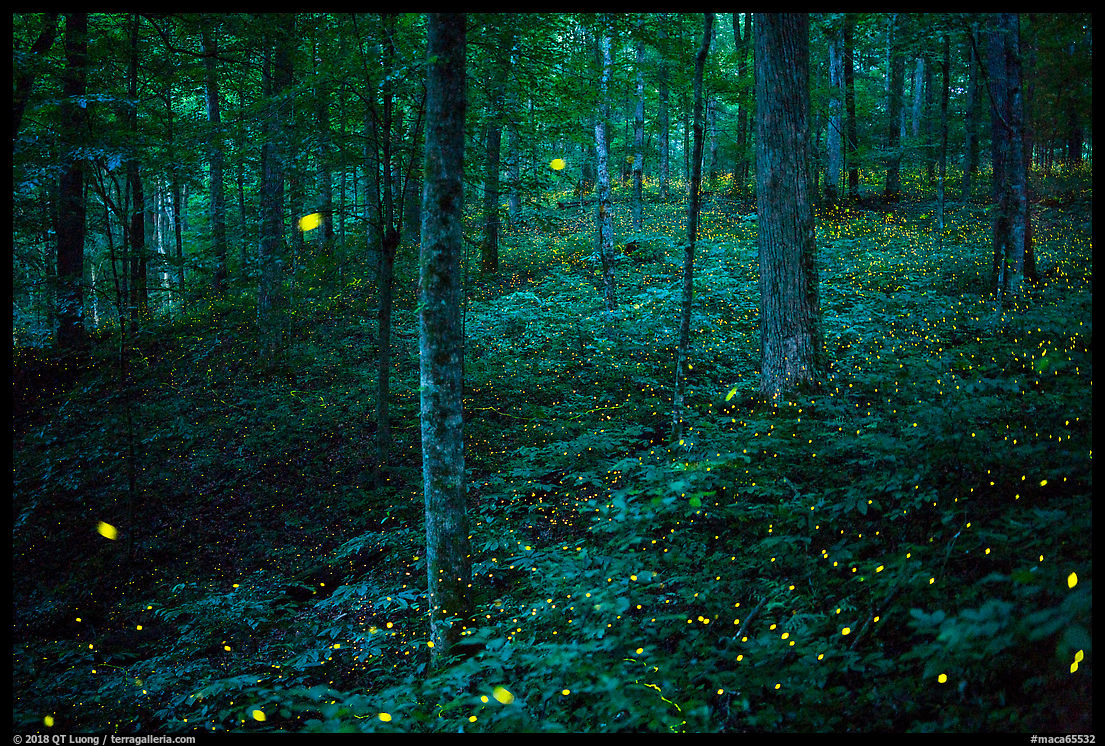
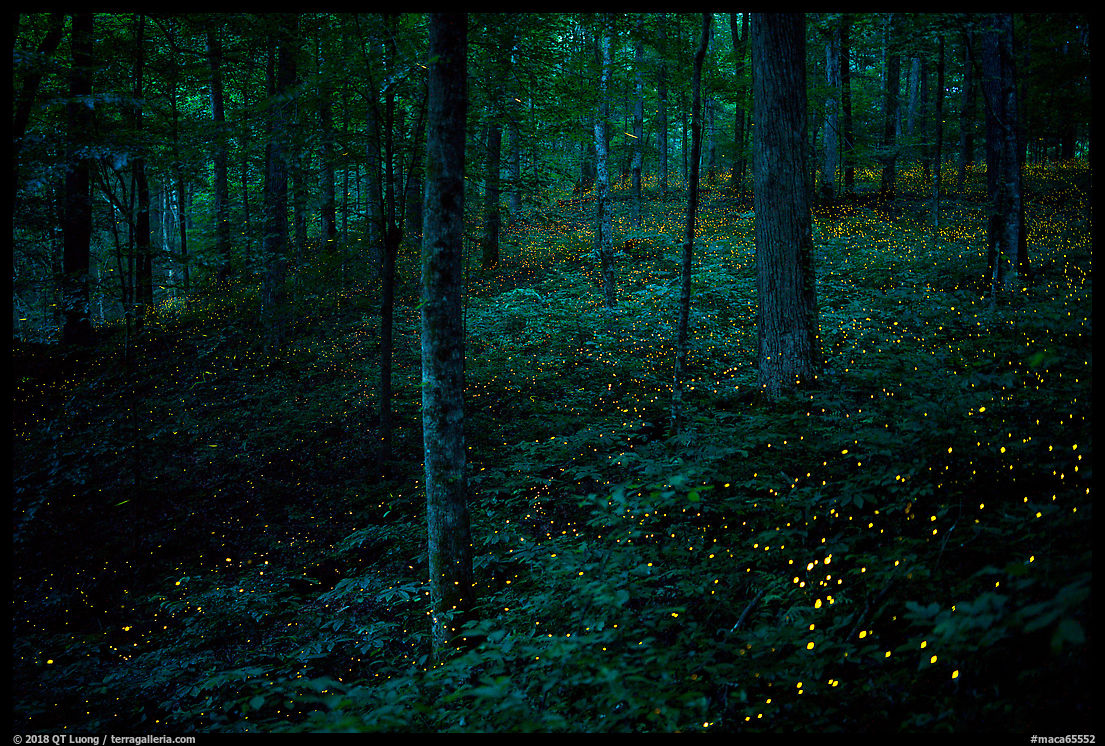
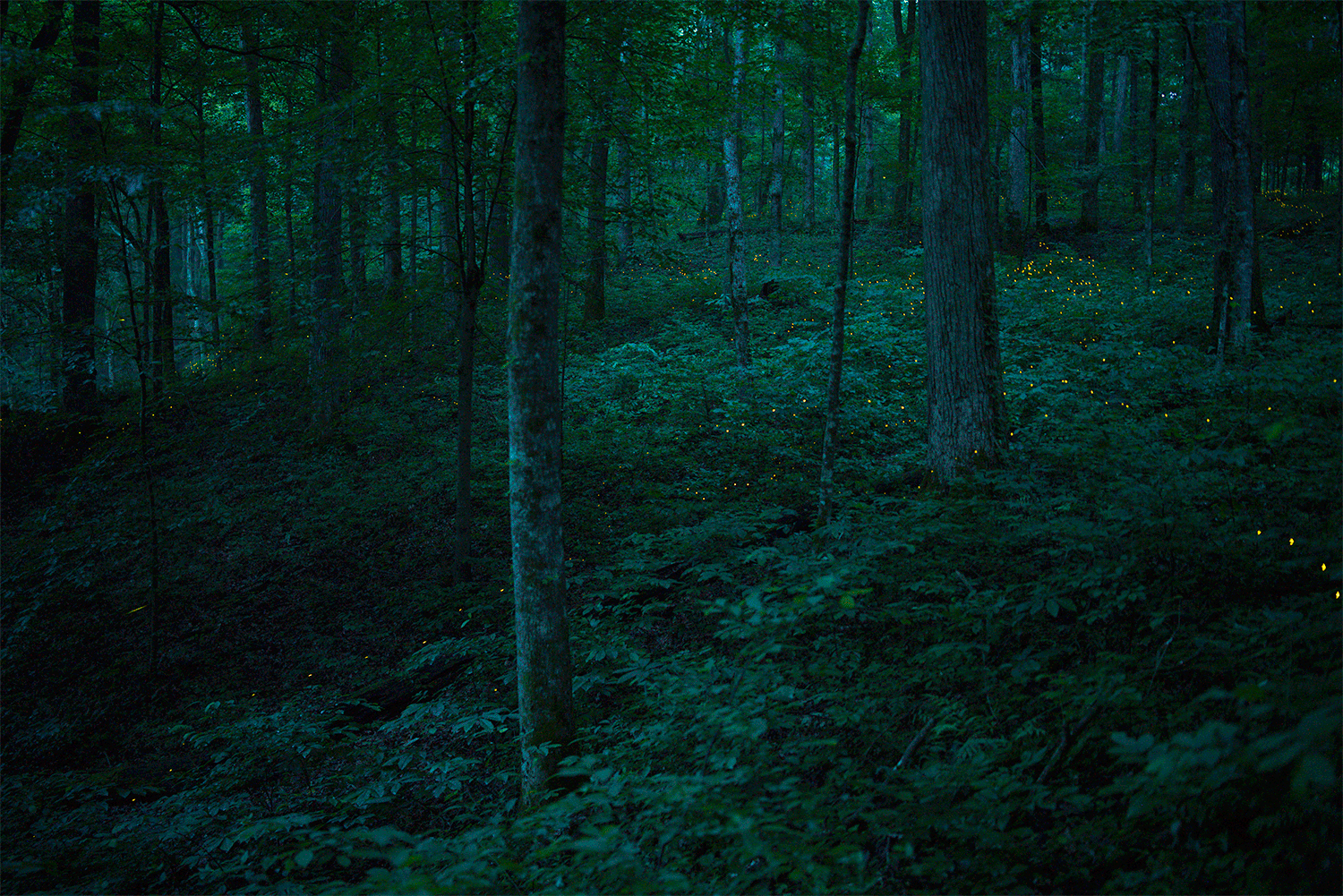
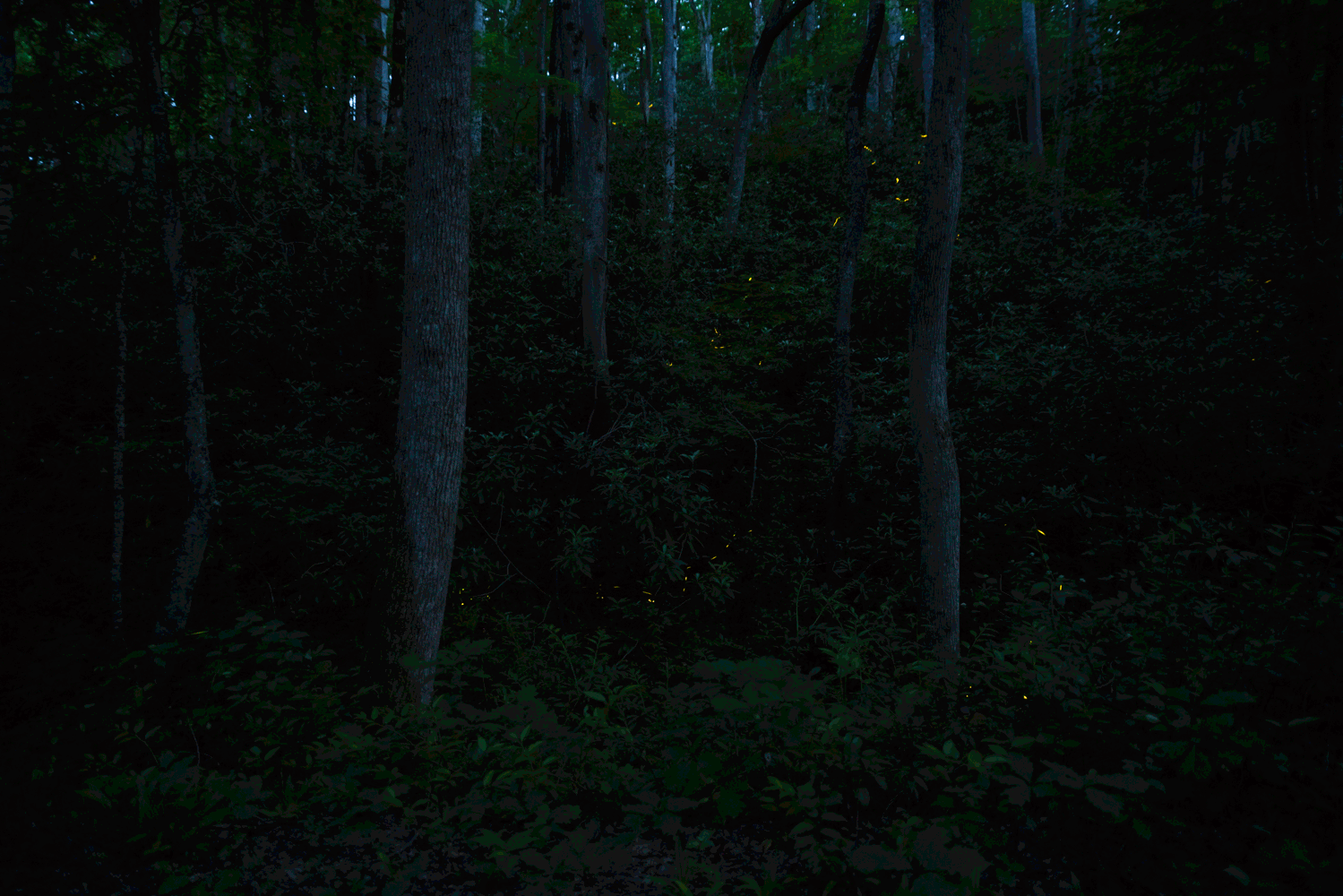


Regarding the first two images, I can see why they’re distracting, but I do find that the big fireflies close to the camera give the single-exposure version that added sense of depth, which I really like. The composite seems, I don’t know, too sedate, less dynamic and alive in comparison. I think I’d love it with just a few closer bugs blended in high up in the frame.
Wonderful images, wonderful series!
There are so many factors at play here that the question is not simply single exposure vs. composite.
1. The composite likely produces a clearer image even though it is hard to see noise in the down sampled single frame.
2. If you carefully select the frames that go into the composite, you may be able to create an image with a visually interesting flight pattern, especially a pattern that conveys motion and 3D (x,y,z). If you just stack a random collection of frames together, then the result will approach a random distribution like a long exposure single frame, thus not taking full advantage of the creative freedom offered by stacking.
3. The out-of-focus blobs are not distracting at all. I think it enhances the image because it conveys a sense of motion and 3D. However, this has nothing to do with single frame vs. composite. It is an artifact of the elevated perspective, which although accentuates x and Y nicely, but nevertheless kills the z axis (height) effect.
4. I agree with Mr. Frishman’s observation of a more sedate and less dynamic and lively composite. I believe this is due to the lack of Z which gives the image a “flat” and “static” appearance as if the bright dots were stationary on the ground. It has nothing to do with the fact that it is a composite.
5. I have observed similar effect or illusion in other photographic situation, e.g., falling snow. A few snow flakes close to the camera, even though out-of-focus, often create wonderful 3D effect.
Thanks Jackson and Tommy for the thoughtful comments. I agree that many of the points that you raise are not about the image being a composite but rather what I chose to do with the composite, namely eliminate fireflies flying high and near the camera. Maybe I should have referred to the images as A and B instead of (“composite” and “single image”. As for the 3D effect, I think the “bokeh perspective” does that nicely, but this isn’t easy to see in small images. I’ve linked larger images for both. Does that change anything for you?
Yes, it does. In the larger image, I can see a clear separation between the bright dots and the ground, so the Z axis is restored and more visible.
While it is sometime fun to totally geek out on comparing images, in all fairness, both images are excellent. Thanks for sharing such amazing natural phenomenon with those of us who prefer not to endure the misery of spending a summer night in a hot and humid forest as mosquito meal.
The tropics have a way of being comforting at night, and those forests have weather like that. Surprisingly for a place that moist (almost a rainforest), there are almost no mosquitoes in the Smokies. I think that is because the water consists of streams, with almost no bodies of standing water. The same could not be said of Congaree (mosquito meter).
Yes, the larger version definitely works better and has more depth! And I can see a lot of bugs higher up the frame that didn’t really come through in the smaller size. Regarding the composite, I’m fine with it in this case where it’s largely functioning as a better quality long exposure. It certainly succeeds in recalling my own experience with a good night of fireflies.
Dear QT,
This is a wonderful resource/tutorial for any interested student. Thank you. Quick question… with f/1.4 and f/2.2, you were working with an extremely narrow dof. Apart from those few out of focus flashes in the foreground, your images appear sharp throughout. Where did you set your focus? My guess is the hyperfocus (as often done for stars), but I could be wrong. Any tips on focusing would be greatly appreciated. Thanks for taking the time to respond.
It depends on what you want to achieve. Hyperfocal distance is a good option for conveying the depth of the forest, but when you focus on the spot with the most activity, it maximizes the number of bugs in focus and draws attention to it.
Thank you so much for sharing your experiences with us! We are getting ready to visit Congaree NP during their Firefly Festival, and I feel much more confident about trying to capture the sights, thanks to all the info you shared.
Also, you did a fantastic job with all the photos, but I personally liked the composite image, better 🙂
This is a great article. Thanks for sharing. My wife and I went for the first time on Sunday night, and we are going back tomorrow night with our college aged kids. Both days, we were able to get a campsite that had a last-minute cancellation.
With the advances in iPhone camera capability since this article was written, do you have any advice on whether an average joe like me could now capture the fire flies with their iPhone camera. I unsuccessfully tried to do so on Sunday night, but a photographer friend of mine recommended using a tripod and putting the phone in pro mode. Unfortunately, I have an iPhone 12, and I don’t think that has pro mode.
Thanks Steve. Glad that you and your family were able to view the event. You definitively want to use a tripod. Try to download an app such as “Slow Shutter” that allows multi-minutes exposures. Since I used such a specialized lens, I would not expect great results with an iPhone, but one never knows!